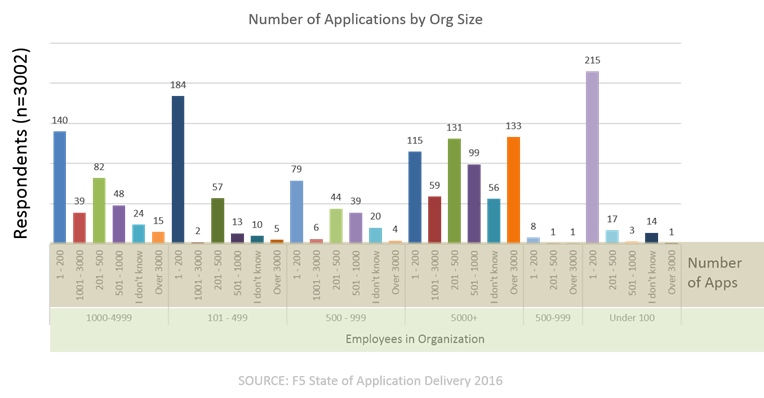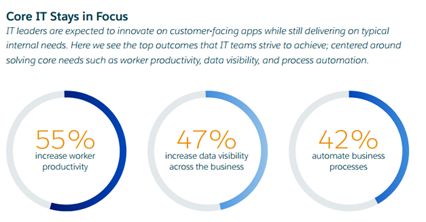Applications. Applications überall.
In den letzten Jahren haben wir (das „Wir“ des Unternehmens) uns eingehend mit den Rechenzentren befasst, um mithilfe unserer Umfragen zum Stand der Application herauszufinden, wie, warum und wo Unternehmen Applications einsetzen und bereitstellen. Unser Schwerpunkt liegt natürlich auf Application , aber es gibt ein breites Spektrum an Technologien und Kontextinformationen, die für dieses Hauptanliegen sowohl relevant als auch interessant sind. Also keine Applications, keine App-Dienste. Applications stehen gewissermaßen im Mittelpunkt des Universums, zumindest von unserem Standort im Netzwerk aus.
Eine der Fragen, die wir stellen, ist einfach, wie viele Applications die Organisation in ihrem Portfolio hat. Diese können sich in der Cloud, im Rechenzentrum, gehostet oder auf einem Mainframe befinden. Wir gehen nicht unbedingt näher darauf ein (da die Umfrage sonst sehr unhandlich werden würde, oder?), sondern möchten lediglich herausfinden, wie viele Applications es in einer bestimmten Organisation tatsächlich gibt.
Denn in der Praxis erleben wir, dass die Applications vielfältig ist. Die durchschnittliche Anzahl virtueller Server (die ungefähr einer Application oder einem Dienst entsprechen) basierend auf der tatsächlichen Nutzung betrug im Juli 2016 122. Das Maximum, das wir gesehen haben? Über 12.000. Ja, das stimmt. Es gibt mindestens eine Organisation, die derzeit über 12.000 virtuelle Server (Applications) betreibt.
Unsere Umfragedaten (und tatsächlichen Daten) zeigen, dass es sich hierbei definitiv um einen Ausreißer handelt. Unseren Daten zufolge verwalten die meisten Unternehmen, mit Ausnahme sehr großer Organisationen (über 5.000 Mitarbeiter), zwischen 1 und 200 Applications.

Tatsächlich liefern 54 % der Befragten weltweit, über alle Unternehmensgrößen hinweg, zwischen 1 und 200 Applications. 23 % liefern zwischen 201 und 500 und weitere 15 % wickeln zwischen 501 und 1.000 ab.
Nur sehr wenige (9 %) fallen in die Kategorie „So hoch kann ich nicht einmal zählen“ von 1001 bis 3000. Aber sie sind da draußen. Und mehr als 3000? Sogar noch weniger.
Laut Ben Kepes, der im Juli 2014 für Forbes.com schrieb , „werden in einem Unternehmen durchschnittlich 508 Applications verwendet.“
Ich denke, diese Zahl repräsentiert ein typisches Großunternehmen recht gut. Bei kleineren Unternehmen würde ich diese Zahl mindestens halbieren.
Dennoch handelt es sich keineswegs um ein unbedeutendes Unterfangen. Selbst wenn 204 Applications skaliert, gesichert und verwaltet werden müssen, ist dies mehr als genug, um die Betriebsteams stärker zu beschäftigen, als ihnen lieb ist.
Der Punkt ist, dass diese Zahl eigentlich steigen sollte. Während eine große Zahl von Applications in die Cloud verlagert wird, insbesondere von standardisierten Business-Apps bis hin zu SaaS-Angeboten, werden diese „Lücken“ durch andere Applications gefüllt. Und bei den meisten davon handelt es sich nicht um umwerfende mobile Apps und Spiele für Kunden.
Laut „State of IT 2016“ von Salesforce.com konzentrieren sich heute 42 % der App-Entwicklungsressourcen auf die Steigerung der Mitarbeiterproduktivität. Apps, die intern eingesetzt werden und auf operative Effizienz abzielen.
Die Automatisierung von Geschäftsprozessen, die Steigerung der Produktivität und die Verbesserung der Datentransparenz im gesamten Unternehmen sind zentrale Anliegen der IT. Viele dieser Anliegen werden durch die Entwicklung von Apps und Systemen angegangen, die diese Ziele erreichen.
Einige werden die Cloud einbeziehen und somit APIs und Integrationsarbeit erfordern, andere werden vor Ort bleiben. Einige erfordern eine mobile App, andere eine einfache webbasierte Schnittstelle. Wenn wir den neuen Best Practices zur „Öffnung“ der IT und zur Ermöglichung einer stärkeren Zusammenarbeit und Wiederverwendung folgen möchten, sollten alle über APIs verfügen.

Ungeachtet dessen erhöhen diese Applications die bestehende Belastung. Und auch sie müssen skaliert, gesichert und verwaltet werden. Sie müssen aktualisiert und integriert werden. Sie tragen zur zunehmenden Ost-West-Verkehrslast bei und wenn es sich um eine externe Cloud-Lösung handelt, erhöhen sie auch die Nord-Süd-Verkehrslast.
Wenn wir an Applications denken, stellen wir uns allzu oft eine schillernde, schön gestaltete mobile Application vor. Aber nicht alle Apps, die das Unternehmen verwaltet, sind solche Apps. Einige davon haben rein praktischen Nutzen, andere dienen lediglich dazu, Daten aus der Ferne zu erfassen und sicher an das Mutterschiff zu übertragen. Dort können die Daten analysiert und an die Analysten übermittelt werden, die sich bei ihren täglichen Geschäftsentscheidungen auf diese Daten verlassen.
Es ist wirklich eine Application , innen und außen.
